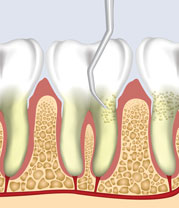
Periodontal disease is a bacterial infection that penetrates into the gums and into the bone around your teeth, causing inflammation. Periodontal inflammation leads to bone loss and possibly tooth loss and may contribute to other medical conditions.
The periodontal infection must be removed and the area given a chance to heal. There are generally two levels of treatment for this condition depending upon the severity of your infection.
Scaling and Root Planing
The upper level of infection in the pockets around your teeth can be removed using specialized instruments. This procedure is called, “Scaling and Root Planing," “Phase One Treatment" or “Initial Therapy." It is done under local anesthesia and is quite different from the routine dental cleaning that is traditionally done in the general dentist's office. In our office this non-surgical procedure is usually performed by the periodontist.
| Scaling and Root Planing | |
|---|---|
 |
 |
Scaling: Your periodontist first removes the upper level of infected calculus. |
Root Planing: Next, he smooths the root to reduce the ability of new bacteria to adhere.
|
Surgical Therapy
If your infection has spread into the bone that supports your teeth and is below the level that can be reached in "Upper Level Infection Removal," then a surgical procedure must be performed to retract the gums and remove the lower level infection.
When periodontal disease reaches this lower level, it dissolves the bone around the teeth and can lead to bone loss. Once the infection has been removed, by closing the surgical site and repositioning the gum tissue. Where possible, bone damaged sites will be evaluated for bone grafting in an effort to regenerate lost bone.